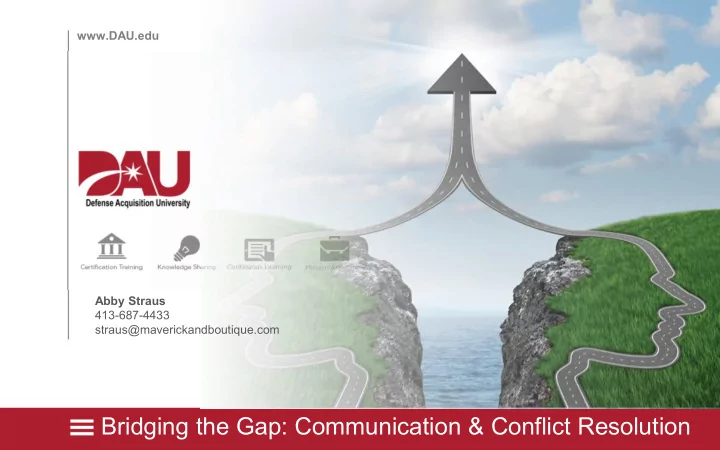

www.DAU.edu Abby Straus 413-687-4433 straus@maverickandboutique.com Bridging the Gap: Communication & Conflict Resolution
Housekeeping: meeting online • Stay fully engaged for the whole session. • Close email and other applications entirely. Silence your phone and notifications. • Mute yourself when you’re not talking. • Leave your video on. • Move into Gallery View if you’re not already so you can see others. • Please rename yourself to include your nickname, if applicable, and where you work at the JPO (click Participants tab on your Zoom screen). • Stuff happens! 2
Topics We’ll Address Today 1. Our challenges around communication and resolving conflict 2. Defining and preparing for great communication 3. Making and responding to requests 4. Giving and receiving feedback 5. Resolving conflict: Getting to Yes 6. REMINDER: NON-CLASSIFIED ONLY 3
Great Communication How would you describe great • communication? What’s going on when it works? What gets in the way of great • communication? What’s going on when it doesn’t work? 4
Prepare to Communicate Rescuer Persecutor Creator Outcome Orientation VISION Challenger Victim Coach OUTCOME FIRST PASSION STEPS EXCITEMENT 5
From Drama to Empowered Communication What drama role is represented in each item below, and how might we shift from Drama to the Empowerment Dynamic (TED*)? 1. It’s not my fault the report is late. Jim didn’t get his data to me on time. 2. How could you even think that? What a stupid idea! 3. Forget it, you do it; I’m hopeless with numbers! 4. I know Anika’s been late a lot. It’s OK, Rescuer Persecutor though, I’ve been covering for her just like I do for the rest of the team. Victim
Make a Clear Request Questions for clarity: 1. What is the objective? What are we trying to achieve? 2. What does “done satisfactorily” looks like? 3. What are the milestones and measures of success? 4. What is the required time for completion? 5. What resources (people, dollars, materials) are available (if applicable)? 6. What communication is required/requested during the process?
Respond to a Request 1. Yes: Can/choose to meet the terms specified Request 2. No: Cannot/choose not to meet the terms specified 3. Negotiate: Suggest new terms, e.g. new completions date + Fo Follo llow-throug ough
Give and Receive Feedback Some challenges • Fear/Anxiety – Lack of trust/suspicious of intentions – Want to feel part of team – Am I the only one receiving this? – What does everyone else think? • Less and less practice with face-to-face interaction • Poor delivery/reception – Awkward/no process – Sudden/Unexpected – Unclear – Bad reaction • Competition for recognition/promotion • Poor timing or not taking enough time 10
Give Feedback • Choose the Outcome Orientation • Ask for permission • Be specific/give examples • Use “I” statements • Ask for summary (if nec.) • Ask, how might I support you? 11
Receive Feedback • Choose the Outcome Orientation • Listen for understanding • Ask clarifying questions • Notice your inner response • Provide a summary of what you heard • If error/correction, acknowledge and be proactive • If compliment, take it in, “Thank you” 12
Resolve Conflict How might we prevent conflict from happening? Negotiation: Steps in “Getting to Yes” 1. People: Separate the people from the problem 2. Emotions: Acknowledge emotions, then set them aside 3. Interests: Focus on interests, not positions 4. Criteria: Use objective criteria 5. Options: Invent multiple options for mutual gain 6. Have a BATNA 13
Be Curious 14
Recap 1. Communication is complex and it’s a two-way street 2. Communicate from the Empowerment Dynamic (TED*) 3. Make and respond to requests with clarity and accountability 4. Get good at giving and receiving feedback 5. Communicate to prevent conflict 6. Practice “Getting to Yes” 7. Be curious to learn and grow as a communicator 15
Reflection • How has your thinking changed today? • How will your behavior change after today? • What would you like to share with someone you know and how will it help them and/or you? 16
Recommend
More recommend